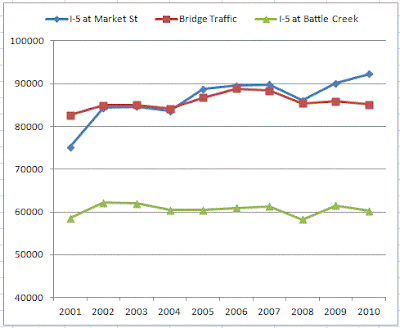 In what might be the start of the PR campaign for the Rivercrossing, headlines in the Statesman today declared that "traffic through Salem increasing" and that the increase was unaffected by the Great Recession.
In what might be the start of the PR campaign for the Rivercrossing, headlines in the Statesman today declared that "traffic through Salem increasing" and that the increase was unaffected by the Great Recession.Here's the traffic count data for I-5 at Market Street:
 It shows a slight uptick. (The x- and y-axis are the same as the bridge graph below.)
It shows a slight uptick. (The x- and y-axis are the same as the bridge graph below.)Here's total miles traveled per person (a rate, not a count do note!) in Oregon.
 (Graph: Impresa Consulting)
(Graph: Impresa Consulting)As a rate it shows a significant decline off the trend.
Here, for comparison's sake, is the bridge traffic across the River.
 Bridge crossings have shown the same plateau and decline that total miles traveled have, so the slight uptick on I-5 is interesting and ambiguous.
Bridge crossings have shown the same plateau and decline that total miles traveled have, so the slight uptick on I-5 is interesting and ambiguous. Rival interpretations of the data will be one of the sites of contention as we debate the need for a very large highway style bridge. Here rates and absolute counts are intermixed. (At my fingertips I don't have an exact apples-to-apples comparison.) It will be interesting to follow this and to learn more about it.

Update, mid-day Sunday
Data! Thanks to Gary in the comments for pointing out more context and comparative data. Here's an updated graph with traffic on the bridges, and two locations on I-5, the Market Street interchange that's discussed in the article and the Battle Creek - Sunnyview interchange on the southern edge of town.
Only the Market Street shows an increase.

Update Dec 8th, 2012
 |
| Data from the Federal Reserve Driving and Recessions do not correlate This change is structural, not cyclical Matthew Yglesias at Slate |


7 comments:
Things that stood out in the article to me:
1. Trips ticking up through Salem while other areas saw drops.
2. New trips possibly being generated by the new Kuebler interchange.
Is it possible that more are using the interstate for local trips? On a somewhat related thought... My recent trip back to Michigan reminded me on one city that was able to build their way out of their congestion problem: Detroit! Ask anyone there now if it was worth the price.
A better title for the Statesman article would have been "I-5 traffic increasing in Salem", as it appears that much of the increase is related to people using I-5 for local trips. Yes, if we build super fast access points to the super fast freeway, and we rezone nearby land from farmland to commercial retail as was done at Keizer Station, cars will come. This statesman article shows the additional travel such development induces. Unfortunately, these long trips out to the suburban fringe do not contribute to the city's economic vitality, livability, citizen health, etc.
Gary
oh, and the data I'm referring to came from here:
http://www.oregon.gov/ODOT/TD/TDATA/tsm/tvt.shtml
A comparison of ADT in 2001 vs 2010 shows little increase in I-5 south of the Battlecreek/Sunnyview interchange (58,500 up to 60,200) while I-5 at Market Street went up by over 22 percent in the same time frame. I-5 just north of Keizer Station went up more than 9 percent.
Gary
Thanks for the link, Gary! Post updated with a new graph.
Themes that came out of the recent budget meetings were the amount we are spending building, policing, servicing, and providing emergency services to folks who work in Salem but don't pay property taxes in Salem. So I guess its not enough that those of us that live in the city have to endure these toxic arterial hellscapes on a daily basis.... we need to pay for them too.
Almost forgot! Yesterday afternoon in Bend was like a dream. After checking in to our house for the week we hooped on our bikes, cruised down Newport Ave. on the Radish with the kids (arterials don't have to be miserable) for a beer, a bite, and groceries. Welcome to the 21st century I thought! The dutch style roundabouts they have put in over here are a dream for kids and families!
Sightline has a new report on gas and mileage in the PNW. "Shifting Into Reverse: Northwest gasoline consumption makes a modest decline"
From the report:
"Two concurrent trends have spurred the reductions in gasoline consumption: people are driving less, and vehicles have become more efficient. Of the two, declines in driving — particularly among northwesterners under the age of 35 — have made the greater impact. Looking to the future, however, gains in vehicle efficiency, combined with high and volatile gas prices, demographic shifts, and a range of social and technological trends, all point towards continued declines in gasoline use in the Pacific Northwest."
Post a Comment